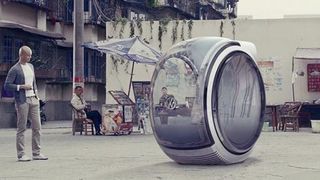Flying cars: how long until takeoff?
Sky-high ideas start to take flight
In 1962, the US army got interested in flying jeeps, and commissioned Chrysler, Curtiss-Wright and Piasecki to build prototypes. Chrysler's VZ-6 flipped over in its first untethered flight, and the Curtiss-Wright VZ-7 failed the meet the army's exacting standards, but the most successful was the Piasecki VZ-8 Airgeep, which came equipped with ejector seats and a tricycle undercarriage, and could even be fitted with floats to make it a flying boatcar. However, despite performing well, the flying jeep programme was eventually cancelled in favour of helicopter development.

In the 70s and 80s, flying cars ceased to become a serious consumer proposition with the rise of popular air travel. Only Paul Moller, a Canadian engineer, persisted with the dream. His Skycar has been in development for around 50 years, at a cost of more than $200,000,000.
Despite being available for pre-order since the 1990s, however, the Skycar M400 has only been demonstrated in public once - hovering, tethered, in 2003. All other announced public demonstrations have been cancelled. In 2007, Moller announced the M200G Volantor, a flying-saucer style hovercar that can fly up to three metres above the ground with the use of fans. In 2009, Moller filed for bankruptcy, but then announced a pair of new designs in 2012.
Practical flying
That brings us up to the present day, and Terrafugia. "There are many lessons to be learnt," says Dietrich of the failures of the past. "Perhaps the biggest and most non-obvious is not to overestimate the rate of adoption of a new form of personal transportation - there is a long history of overly optimistic business plans in this space."
Of course, Terrafugia isn't the only company working on flying cars and similar vehicles. Aerofex are looking at hoverbikes, Volkswagen has a hovercar concept that uses electromagnetic levitation, and Hyundai engineers also submitted a design for a flying car to the company's annual ideas content. An Israeli company, Urban Aeronautics, is getting in on the action too with its X-Hawk.

But right now it looks like Terrafugia's Transition is the closest to something we might actually be driving in the sky. "The Transition is the practical flying car that we can certify with today's regulations, and TF-X is the flying car we could build with today's technology - and that we intend to create once we develop the certification path," said Dietrich.
"Our plan is to get a relatively simple product, the Transition, to market as soon as possible while writing new international standards that will be used as the basis for future, more rapid, aircraft certification," he added.
Get daily insight, inspiration and deals in your inbox
Get the hottest deals available in your inbox plus news, reviews, opinion, analysis and more from the TechRadar team.
"Then leverage the associated revenue, experience base, intellectual property base, and credibility to create the flying car that is as close as possible to the ideal form of personal transportation that we can achieve today."
If Dietrich gets his way, that flying car might not be so far away after all.
Most Popular





